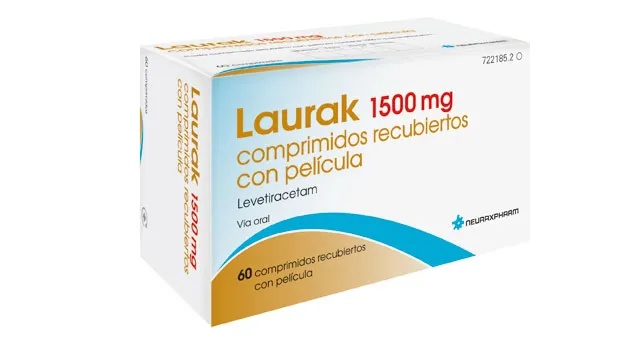

LAURAK 1500 mg COMPRIMIDOS REVESTIDOS POR PELÍCULA

Pergunte a um médico sobre a prescrição de LAURAK 1500 mg COMPRIMIDOS REVESTIDOS POR PELÍCULA

Como usar LAURAK 1500 mg COMPRIMIDOS REVESTIDOS POR PELÍCULA
Introdução
Prospecto: informação para o utilizador
Laurak 1500 mg comprimidos revestidos por película
Levetiracetam
Leia todo o prospecto detenidamente antes de começar a tomar este medicamento, porque contém informações importantes para si.
- Conserva este prospecto, porque pode ter que voltar a lê-lo.
- Se tiver alguma dúvida, consulte o seu médico ou farmacêutico.
- Este medicamento foi-lhe prescrito apenas para si, e não deve dá-lo a outras pessoas, mesmo que tenham os mesmos sintomas que si, porque pode prejudicá-las.
- Se experimentar efeitos adversos, consulte o seu médico ou farmacêutico, mesmo que se trate de efeitos adversos que não aparecem neste prospecto. Ver secção 4.
Conteúdo do prospecto
- O que é Laurak e para que é utilizado
- O que necessita de saber antes de começar a tomar Laurak
- Como tomar Laurak
- Possíveis efeitos adversos
- Conservação de Laurak
- Conteúdo do envase e informação adicional
1. O que é Laurak e para que é utilizado
Levetiracetam é um medicamento antiepiléptico (um medicamento para o tratamento de crises na epilepsia).
Levetiracetam é utilizado:
- em monoterapia em adultos e adolescentes de 16 anos de idade ou mais com epilepsia diagnosticada recentemente para tratar uma forma de epilepsia. A epilepsia é uma doença onde os pacientes têm ataques (crises). Levetiracetam é utilizado para a forma de epilepsia na qual as crises inicialmente afetam apenas um lado do cérebro, mas podem depois estender-se a zonas mais amplas nos dois lados do cérebro (crises de início parcial com ou sem generalização secundária). O seu médico prescreveu-lhe levetiracetam para reduzir o número de crises.
- conjuntamente com outros medicamentos antiepilépticos para tratar:
- as crises de início parcial com ou sem generalização em adultos, adolescentes, crianças e lactentes a partir de 1 mês de idade
- as crises mioclónicas (sacudidas tipo choque, curtas, de um músculo ou grupo de músculos) em adultos e adolescentes a partir de 12 anos com epilepsia mioclónica juvenil.
- as crises tónico-clónicas generalizadas primárias (crises maiores, incluindo perda de consciência) em adultos e adolescentes a partir de 12 anos de idade com epilepsia idiopática generalizada (tipo de epilepsia que se pensa que tem uma causa genética).
2. O que necessita de saber antes de começar a tomar Laurak
Não tome Laurak
- Se é alérgico a levetiracetam, aos derivados de pirrolidina ou a algum dos outros componentes deste medicamento (incluídos na secção 6).
Advertências e precauções
Consulte o seu médico ou farmacêutico antes de começar a tomar este medicamento:
- Se sofre de problemas renais, siga as instruções do seu médico, que decidirá se deve ajustar a dose a tomar.
- Se observar qualquer diminuição no crescimento do seu filho ou desenvolvimento da puberdade inesperado, contacte o seu médico.
- Um pequeno número de pessoas em tratamento com antiepilépticos, tais como levetiracetam, tiveram pensamentos de se fazerem mal ou suicidarem-se. Se tiver algum sintoma de depressão e/ou pensamentos suicidas, contacte o seu médico.
- Se tem antecedentes médicos ou familiares de ritmo cardíaco irregular (visível no eletrocardiograma), ou se tem uma doença e/ou toma um tratamento que o faça propenso a arritmias cardíacas ou desequilíbrios de sais.
Informa ao seu médico ou farmacêutico se algum dos seguintes efeitos adversos se agravar ou durar mais de alguns dias:
- Pensamentos anormais, sensação de irritabilidade ou reacção de forma mais agressiva do que o normal ou se si ou a sua família e amigos notam mudanças importantes no estado de ânimo ou comportamento.
- Agravamento da epilepsia.
Em raros casos, as crises epilépticas podem piorar ou ocorrer com mais frequência, principalmente durante o primeiro mês após o início do tratamento ou do aumento da dose. Se experimentar algum desses sintomas novos enquanto toma Laurak, vá a um médico o mais rápido possível.
Crianças e adolescentes
O tratamento exclusivo de levetiracetam (monoterapia) não é indicado em crianças e adolescentes menores de 16 anos.
Uso de Laurak com outros medicamentos
Informa ao seu médico ou farmacêutico se está a tomar, tomou recentemente ou pode ter que tomar qualquer outro medicamento.
Não tome macrogol (medicamento utilizado como laxante) durante uma hora antes e uma hora após tomar levetiracetam, pois poderia perder o seu efeito.
Gravidez, amamentação e fertilidade
Se está grávida ou em período de amamentação, acredita que possa estar grávida ou tem intenção de ficar grávida, consulte o seu médico antes de utilizar este medicamento.
Laurak não deve ser utilizado durante a gravidez, a menos que seja estritamente necessário. Não se pode excluir completamente o risco de defeitos de nascimento para o bebê.
Não se recomenda a amamentação natural durante o tratamento.
Condução e uso de máquinas
Levetiracetam pode alterar a sua capacidade para conduzir ou manejar ferramentas ou máquinas, pois pode produzir-lhe sensação de sono. Isto é mais provável no início do tratamento ou quando se aumenta a dose. Não deve conduzir ou utilizar máquinas até que se verifique que a sua capacidade para realizar estas atividades não está afetada.
3. Como tomar Laurak
Siga exatamente as instruções de administração deste medicamento indicadas pelo seu médico ou farmacêutico. Em caso de dúvida, consulte novamente o seu médico ou farmacêutico.
Tome o número de comprimidos que o seu médico lhe prescreveu.
Levetiracetam deve ser tomado duas vezes ao dia, uma vez de manhã e outra à noite, aproximadamente à mesma hora todos os dias.
Monoterapia
Dose em adultos (≥18 anos) e adolescentes (desde 16anos de idade):
Dose geral: entre 1.000 mg e 3.000 mg ao dia.
Quando começar a tomar levetiracetam, o seu médico prescrever-lhe-á uma dose inferiordurante duas semanas antes de administrar-lhe a dose geral mais baixa.
Terapia concomitante
Dose em adultos e adolescentes (de 12 a 17 anos) com um peso de 50 kg ou superior:
Dose geral: entre 1.000 mg e 3.000 mg ao dia. O seu médico prescrever-lhe-á a forma farmacêutica e dose apropriada de acordo com o seu peso.
Dose em lactentes (de 1 mês a 23 meses), crianças (de 2 a 11 anos) e adolescentes (de 12 a 17 anos) com um peso inferior a 50 kg:
O seu médico prescrever-lhe-á a forma farmacêutica de levetiracetam mais apropriada de acordo com a idade, o peso e a dose.
Forma de administração
Engula os comprimidos de levetiracetam com uma quantidade suficiente de líquido (p. ex. um copo de água).
Pode tomar levetiracetam com ou sem alimentos. Após a administração oral de levetiracetam, pode apreciar o seu sabor amargo.
Duração do tratamento
- Levetiracetam é utilizado como um tratamento crónico. Deve continuar com o tratamento com levetiracetam durante o tempo indicado pelo seu médico.
- Não deixe o tratamento sem a recomendação do seu médico, pois podem aumentar as suas crises.
Se tomar mais Laurak do que deve
Em caso de sobredose ou ingestão acidental, consulte imediatamente o seu médico ou farmacêutico ou ligue para o Serviço de Informação Toxicológica, telefone: 91 562 04 20, indicando o medicamento e a quantidade ingerida.
Os possíveis efeitos adversos de uma sobredose de levetiracetam são sonolência, agitação, agressividade, diminuição da alerta, inibição da respiração e coma. Contacte o seu médico se tomou mais comprimidos do que devia. O seu médico estabelecerá o melhor tratamento possível da sobredose.
Se esquecer de tomar Laurak
Contacte o seu médico se deixou de tomar uma ou mais doses.
Não tome uma dose dupla para compensar as doses esquecidas.
Se interromper o tratamento com Laurak
A finalização do tratamento com levetiracetam deve ser feita de forma gradual para evitar um aumento das crises. Se o seu médico decidir parar o tratamento com levetiracetam, ele/ela dar-lhe-á as instruções para a retirada gradual de levetiracetam.
Se tiver alguma outra dúvida sobre o uso deste medicamento, pergunte ao seu médico ou farmacêutico.
4. Possíveis efeitos adversos
Como todos os medicamentos, este medicamento pode produzir efeitos adversos, embora nem todas as pessoas os sofram.
Informa ao seu médico imediatamente, ou vá ao serviço de urgências do seu hospital mais próximo se experimentar:
- debilidade, tontura ou dificuldade para respirar, pois estes podem ser sinais de uma reação alérgica (anafiláctica) grave;
- inchaço da face, lábios, língua ou garganta (edema de Quincke);
- sintomas de gripe e erupção na face seguido de uma erupção prolongada com temperatura elevada, níveis de enzimas hepáticas elevados em testes sanguíneos e um aumento em um tipo de células brancas sanguíneas (eosinofilia) e nódulos linfáticos aumentados (Reação de hipersensibilidade ao medicamento com eosinofilia e sintomas sistémicos (DRESS));
- sintomas como baixo volume de urina, cansaço, náuseas, vómitos, confusão e inchaço de pernas, braços ou pés, pois pode ser um sinal de diminuição súbita da função renal;
- uma erupção cutânea que pode formar bolhas e pode aparecer como pequenas dianas (pontos centrais escuros rodeados por uma área mais pálida, com um anel escuro ao redor da borda) (eritema multiforme);
- uma erupção generalizada com bolhas e descamação da pele, especialmente ao redor da boca, nariz, olhos e genitais (síndrome de Stevens-Johnson);
- uma forma mais grave que causa descamação da pele em mais de 30% da superfície corporal (necrólise epidérmica tóxica);
- sinais de mudanças mentais graves ou se alguém ao seu redor nota sinais de confusão, sonolência (adormecimento), amnésia (perda de memória), deterioração da memória (esquecimento), comportamento anormal ou outros sinais neurológicos, incluindo movimentos involuntários ou incontrolados. Estes podem ser sintomas de encefalopatia.
Os efeitos adversos notificados mais frequentemente são nasofaringite, sonolência (sensação de sono), dor de cabeça, fadiga e tontura. Os efeitos adversos como sensação de sono, sensação de fraqueza e tonturas podem ser mais frequentes quando se inicia o tratamento ou se aumenta a dose. No entanto, estes efeitos adversos devem diminuir com o tempo.
Muito frequentes:podem afetar mais de 1 em cada 10 pessoas
- nasofaringite;
- sonolência (sensação de sono), dor de cabeça.
Frequentes:podem afetar até 1 em cada 10 pessoas
- anorexia (perda de apetite);
- depressão, hostilidade ou agressividade, ansiedade, insónia, nervosismo ou irritabilidade;
- convulsões, distúrbio do equilíbrio, tontura (sensação de instabilidade), letargia (falta de energia e entusiasmo), tremor (tremor involuntário);
- vértigo (sensação de rotação);
- tosse;
- dor abdominal, diarreia, dispepsia (indigestão), vómitos, náuseas;
- erupção na pele;
- astenia/fadiga (sensação de fraqueza).
Pouco frequentes:podem afetar até 1 em cada 100 pessoas
- diminuição do número de plaquetas, diminuição dos glóbulos brancos;
- perda de peso, aumento de peso;
- tentativa de suicídio e pensamentos suicidas, alterações mentais, comportamento anormal,
- alucinações, cólera, confusão, ataque de pânico, instabilidade emocional/mudanças de humor, agitação;
- amnésia (perda de memória), deterioração da memória (falta de memória), coordenação anormal/ataxia (coordenação dos movimentos alterada), parestesia (formigamento), alterações da atenção (perda de concentração);
- diplopia (visão dupla), visão borrosa;
- valores elevados/anormais nos testes sobre a funcionalidade do fígado;
- perda de cabelo, eczema, prurido;
- fraqueza muscular, mialgia (dor muscular);
- lesão.
Raros:podem afetar até 1 em cada 1.000 pessoas
- infecção;
- diminuição de todos os tipos de células sanguíneas;
- reações alérgicas graves (DRESS, reação anafiláctica (reação alérgica importante e grave), edema de Quincke (inchaço da face, lábios, língua e garganta));
- diminuição da concentração de sódio no sangue;
- suicídio, distúrbios da personalidade (problemas de comportamento), pensamento anormal (pensamento lento, dificuldade para se concentrar);
- delírio;
- encefalopatia (ver subseção “Informa ao seu médico imediatamente” para ver uma descrição detalhada dos sintomas);
- as crises epilépticas podem piorar ou ocorrer com mais frequência;
- espasmos musculares incontroláveis que afetam a cabeça, o torso e as extremidades, dificuldade para controlar os movimentos, hipercinesia (hiperatividade);
- mudança do ritmo cardíaco (eletrocardiograma);
- pancreatite (inflamação do pâncreas);
- insuficiência hepática, hepatite (inflamação do fígado);
- diminuição súbita da função renal;
- erupção cutânea, que pode dar lugar a bolhas que podem aparecer como pequenas dianas (pontos centrais escuros rodeados por uma área mais pálida, com um anel escuro ao redor da borda) (eritema multiforme), uma erupção generalizada com bolhas e descamação da pele, especialmente ao redor da boca, nariz, olhos e genitais (síndrome de Stevens-Johnson) e uma forma mais grave que causa descamação da pele em mais de 30% da superfície corporal (necrólise epidérmica tóxica);
- rabdomiólise (rotura do tecido muscular) e aumento de creatina fosfoquinase sanguínea associado. A prevalência é significativamente maior em pacientes japoneses em comparação com pacientes não japoneses.
- coxeira ou dificuldade para caminhar;
- combinação de febre, rigidez muscular, pressão arterial e frequência cardíaca instáveis, confusão, estado de baixo nível de consciência (podem ser sinais de um distúrbio chamado síndrome neuroléptico maligno). A prevalência é significativamente maior em pacientes japoneses em comparação com pacientes não japoneses.
Comunicação de efeitos adversos
Se experimentar qualquer tipo de efeito adverso, consulte o seu médico ou farmacêutico, mesmo que se trate de possíveis efeitos adversos que não aparecem neste prospecto. Também pode comunicá-los diretamente através do Sistema Espanhol de Farmacovigilância de medicamentos de Uso Humano: https://www.notificaram.es. Mediante a comunicação de efeitos adversos, você pode contribuir para proporcionar mais informações sobre a segurança deste medicamento.
5. Conservação de Laurak
Mantenha este medicamento fora da vista e do alcance das crianças.
Não utilize este medicamento após a data de caducidade que aparece no cartonagem após CAD. A data de caducidade é o último dia do mês que se indica.
Este medicamento não requer condições especiais de conservação.
Os medicamentos não devem ser jogados nos esgotos nem na lixeira. Deposite os envases e os medicamentos que não precisa no Ponto SIGRE da farmácia. Em caso de dúvida, pergunte ao seu farmacêutico como se livrar dos envases e dos medicamentos que já não precisa. Dessa forma, ajudará a proteger o meio ambiente.
6. Conteúdo do envase e informação adicional
Composição de Laurak
- O princípio ativo é levetiracetam. Cada comprimido revestido com película contém 1.500 mg de levetiracetam.
- Os outros componentes são:
Núcleo do comprimido:crospovidona tipo A, povidona K30, sílica coloidal anidra, estearato de magnésio.
Revestimento:Hipromelosa, dióxido de titânio (E-171), talco, macrogol 400, dióxido de ferro amarelo (E172), laca de alumínio índigo carmim (E132).
Aspecto do produto e conteúdo do envase
Laurak 1.500mg comprimidos revestidos por película são decor verde, ovais e marcados com uma ranhura em uma face do comprimido.
O comprimido pode ser dividido em doses iguais.
Laurak está acondicionado em blisters e disponível em envases contendo 30, 50 ou 60 comprimidos.
Pode ser que apenas alguns tamanhos de envases estejam comercializados.
Titular da autorização de comercialização e responsável pela fabricação
Titular da autorização de comercialização:
Neuraxpharm Spain, S.L.U.
Avda. Barcelona, 69
08970 Sant Joan Despí
Barcelona - Espanha
Responsável pela fabricação:
Rontis Hellas Medical and Pharmaceutical Products, S.A.
P.O. Box 3012 Larisa Industrial Area
41004 Larisa
Grécia
PharOS MT Ltd.
HF 62X, Hal Far Industrial Estate, Birzebbugia,
BBG 3000, Malta
Este medicamento está autorizado nos estados membros do Espaço Económico Europeu sob os seguintes nomes:
Alemanha: | Laurak 1500 mg Filmtabletten |
Espanha: | Laurak 1500 mg comprimidos revestidos por película |
Portugal: | Laurak 1500 mg comprimidos revestidos por película |
Data da última revisão deste prospecto: Março 2023
A informação detalhada e atualizada deste medicamento está disponível na página web da Agência Espanhola de Medicamentos e Produtos Sanitários (AEMPS) (http://www.aemps.gob.es)

Quanto custa o LAURAK 1500 mg COMPRIMIDOS REVESTIDOS POR PELÍCULA em Espanha em 2025?
O preço médio do LAURAK 1500 mg COMPRIMIDOS REVESTIDOS POR PELÍCULA em dezembro de 2025 é de cerca de 156.73 EUR. Os valores podem variar consoante a região, a farmácia e a necessidade de receita. Confirme sempre com uma farmácia local ou fonte online para obter informações atualizadas.
- País de registo
- Preço médio em farmácia156.73 EUR
- Substância ativa
- Requer receita médicaSim
- Fabricante
- Esta informação é apenas para referência e não constitui aconselhamento médico. Consulte sempre um médico antes de tomar qualquer medicamento. A Oladoctor não se responsabiliza por decisões médicas baseadas neste conteúdo.
- Alternativas a LAURAK 1500 mg COMPRIMIDOS REVESTIDOS POR PELÍCULAForma farmacêutica: PERFURAÇÃO INJETÁVEL, 100 mgSubstância ativa: levetiracetamFabricante: Ucb PharmaRequer receita médicaForma farmacêutica: PERFURAÇÃO INJETÁVEL, 100 mg/mlSubstância ativa: levetiracetamFabricante: Ucb PharmaRequer receita médicaForma farmacêutica: SOLUÇÃO/SUSPENSÃO ORAL, 100 mgSubstância ativa: levetiracetamFabricante: Ucb PharmaRequer receita médica
Alternativas a LAURAK 1500 mg COMPRIMIDOS REVESTIDOS POR PELÍCULA noutros países
As melhores alternativas com o mesmo princípio ativo e efeito terapêutico.
Alternativa a LAURAK 1500 mg COMPRIMIDOS REVESTIDOS POR PELÍCULA em Polonia
Alternativa a LAURAK 1500 mg COMPRIMIDOS REVESTIDOS POR PELÍCULA em Ucrania
Médicos online para LAURAK 1500 mg COMPRIMIDOS REVESTIDOS POR PELÍCULA
Avaliação de posologia, efeitos secundários, interações, contraindicações e renovação da receita de LAURAK 1500 mg COMPRIMIDOS REVESTIDOS POR PELÍCULA – sujeita a avaliação médica e regras locais.







